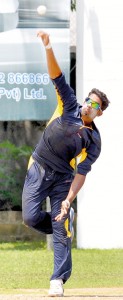Aussie university raises doubts over ICC integrity
Has the International Cricket Council (ICC) stolen or copied a system that was developed by the University of Western Australia (UWA) to detect and remedy illegal bowling actions and is it manipulating this method to please the Big Three.
These questions have arisen following a report circulated among Sri Lanka Cricket Executive Committee members. The Sunday Times has a copy of this report.
The report quotes UWA authorities as claiming that that “their Testing Protocol constructed and developed for over 20 years for bowlers in cricket which is their Intellectual property that has been stolen/copied by the ICC, who have set up their own Testing Standards which may be inconsistent resulting in having flaws in their testing protocols.”
Lankan off spinner Sachithra Senanayake who was found flexing 39 to 44 degrees in his over-the-wicket delivery and 36 to 40 degrees while operating round the wicket at the tests that he underwent at the Cardiff University, Wales was shown the ‘red light’ by the ICC. The world body indicated that he would not be able to operate at competitive levels. The ICC said, “It is recommended that Mr. Senanayake should not be permitted to bowl until he has undertaken remedial work to address elbow extension levels.”
However, another question at hand is that Senanayake was tested at the Cardiff University by Dr. Andrea Cutti (Consultant, ICC Biomechanics), an Italian National, and Craig Ranson (Cardiff Metropolitan University, Sports & Exercise Medicine), but the method of how they arrived at their decision was not explained.
Reciprocally, Senanayake was sent to the University of Western Australia to be tested under Daryl Foster and at one point UWA tests say, “After remediation, in two methods (M2 & M3), the elbow extension falls under the 15 degree threshold and in the other (M1) he is above. This is why the ICC must clarify the methodology they are using to model the data. Until they do, we are flying blind with regard to how much further remediation he requires. Though I do believe we need to work on continuing to reduce his maximum flexion levels (mid-forward swing).”
The Lankan cricket authorities on more than one occasion have requested the ICC to release its Testing Protocol, but only got a negative reply.
Intriguingly, the recent crackdown on bowlers with suspect actions so far has not affected any bowler from the “big Three” which incidentally also hijacked the controlling power of the ICC a few months ago.
When senior vice president of SLC Mohan de Silva was asked for comment, he said “We are fully supportive of the ICC’s endeavour to eradicate suspect bowling actions as far as they are consistent in their action”
Cricketers in the calibre of Sir Vivian Richards, Arjuna Ranatunga and Rameez Raja have questioned the timing of this exercise where they are hunting down leading wicket takers of most of the Test playing nations.
The Sydney Morning Herald in a recent article also questioned the ICC’s independence and allege that the ICC has violated copyright rules.
The article by Chloe Saltau, the newspaper’s chief cricket writers, says:
The University of Western Australia, until recently the main destination for bowlers with dubious actions, has cast doubt on the independence of the International Cricket Council’s new testing procedures as the governing body cracks down on suspected chuckers.
A leading biomechanist from the university says it withdrew its services from the ICC in March because of a dispute over its intellectual property, which it claims the ICC is using to replicate its model for testing bowlers who are reported for throwing.
Since March, New Zealand’s Kane Williamson and Sri Lanka’s Sachithra Senanayake have been banned from bowling in international cricket after tests at Cardiff Metropolitan University in Wales found their elbow extension exceeded the 15-degree limit. Pakistan’s dangerous off-spinner Saeed Ajmal became the biggest name reported so far and his availability has massive implications for Australia’s Test series in the United Arab Emirates in October.
Professor Jacqueline Alderson said the University of Western Australia supported the concept of multiple testing laboratories around the world, and was still available to national cricket boards whose players needed to improve their actions, but she said the ICC had effectively taken control of the testing process.


